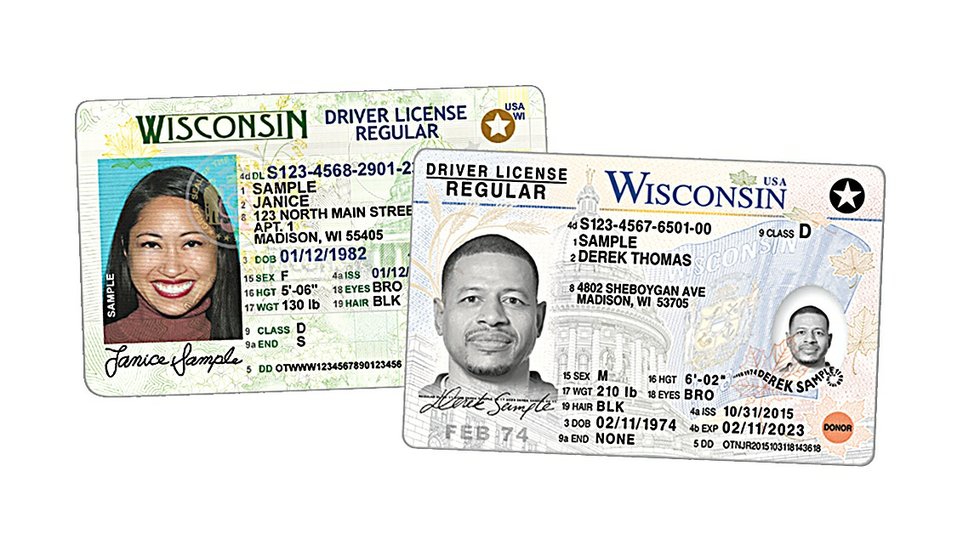Your current driver’s license might not be good enough for air travel starting Oct. 1

A star in a gold or black circle in the right corner indicates a REAL ID compliant Wisconsin driver’s license. Everyone will need a REAL ID form of identification (which includes a valid passport) to fly even domestically starting in October.
If you plan to fly anywhere within the U.S. as of Oct. 1, 2020, you will need a REAL ID driver’s license or REAL ID compliant identification (like a military card or passport) to show at the security checkpoint or you won’t get on that flight.
No exceptions.
And there’s a good chance your current Wisconsin driver’s license does not meet this new federal requirement.
“New” federal requirement is not exactly accurate. The law was passed in 2005, but Wisconsin didn’t begin offering REAL ID licenses until 2013, and then only as an option when you renewed or first received your driver’s license.
Not sure if you have a REAL ID? Pull out your driver’s license and take a look. A star inside a gold or black circle in the upper right corner means it’s REAL ID compliant, says Frank Pipia, Transportation Security Administration (TSA) Stakeholder Manager for the state of Wisconsin.
If you don’t see that star— or you see the words “Not for federal purposes”— head to your local Department of Motor Vehicles (DMV) for the upgrade, and make sure you bring proper documentation.
It’s best to check immediately, rather than arriving at the airport only to find you won’t be allowed to pass through security and board the plane. The REAL ID requirement applies to those 18 years and older, and also for visiting a military base, federal, or nuclear facility.
The REAL ID Act was passed in 2005 by Congress when the 9/11 Commission set federal standards for identification required to fly within the U.S. “So everybody would be the same and it could be used in place of a passport for U.S. travel,” says Pipia. “This sets minimum security standards.”
REAL ID cards do not cover international travel. You’ll still need a valid passport for that.
If you’re renewing your regular driver’s license or ID card, upgrading to a REAL ID is done at no additional charge (regular renewal fees do apply), according to the Wisconsin DOT website.
If your current license or identification card does not expire before 2020, the cost of a duplicate card will apply if you obtain a REAL ID-compliant card.
In either case, you’ll need to bring additional documentation such as a valid passport, or birth certificate, marriage certificate and other proofs of identity. Find a detailed list of documents and more information at wisconsindot.gov, and search “real id.”
A passport is the gold standard of identification and is a REAL ID-compliant document for travel domestically and is required for international travel. The Marathon County Clerk’s office is among the handful of local places that can process a passport application. According to the clerk’s office, the typical passport issuance can take up to eight weeks, but can be expedited for an additional fee. You can also get a passport application at the Marathon County Public Library in Wausau, and the post offices in Wausau, Schofield, Marathon, Mosinee, Merrill, and Wittenberg.
Another thing about security: Time
Once you have the proper documents to fly, make sure your trip is as seamless as possible by arriving at the airport with enough time to pass through the TSA checkpoints and get to the gate. This holds true even at the smaller, regional airports.
More and more people are flying as airline prices are continuing to drop, says Brian Grefe, director of Central Wisconsin Airport (CWA). “And, we see more travelers are choosing to fly CWA rather than deal with the headache of driving long distances to large and challenging airports.”
That makes for longer TSA lines even in a smaller airport like CWA. Always arrive at the airport at least 90 minutes before a scheduled departure, Grefe says. “You also need to consider other things like unforeseen traffic issues, weather conditions or maybe the return of a rental car.”
Some people still believe they can come 45 minutes prior to departure at CWA and make a flight. Don’t chance it. “Most of the airlines shut down ticketing 30 minutes prior to departure,” Grefe says. “We still see people cutting it way too close… Today we had two people miss flights due to the time they arrived.”
CWA serves three major airlines, and on some days four flights leave within an hour of each other. “It’s now so compressed,” he says. “You could have 200 people going through a checkpoint that can only accommodate realistically 130 passengers an hour, and that’s assuming everything is going well.”
For people who don’t travel often, security rules about what can be packed may be confusing. The 3-1-1 liquids rule (3.4 oz., one bag, one passenger) for carry-ons seems to create the most problems and angst: Each passenger is allowed one quart-size container or bag for items such as liquids, gels or aerosols, each under 3.4 ounces. That includes toothpaste, mouthwash, lotion, etc. All liquids must fit in that one container or bag. (There are exceptions for liquids such as breast milk).
Make sure items that need to be taken out to be screened in the security line— such as laptops and tablets — are packed at the top of their bags for easy access.
Rules do change, so always be sure to check what is or is not allowed in your luggage at tsa.gov.
Finally, Pipia says having your identification and boarding pass ready for the various security and ticketing points helps move things along.




